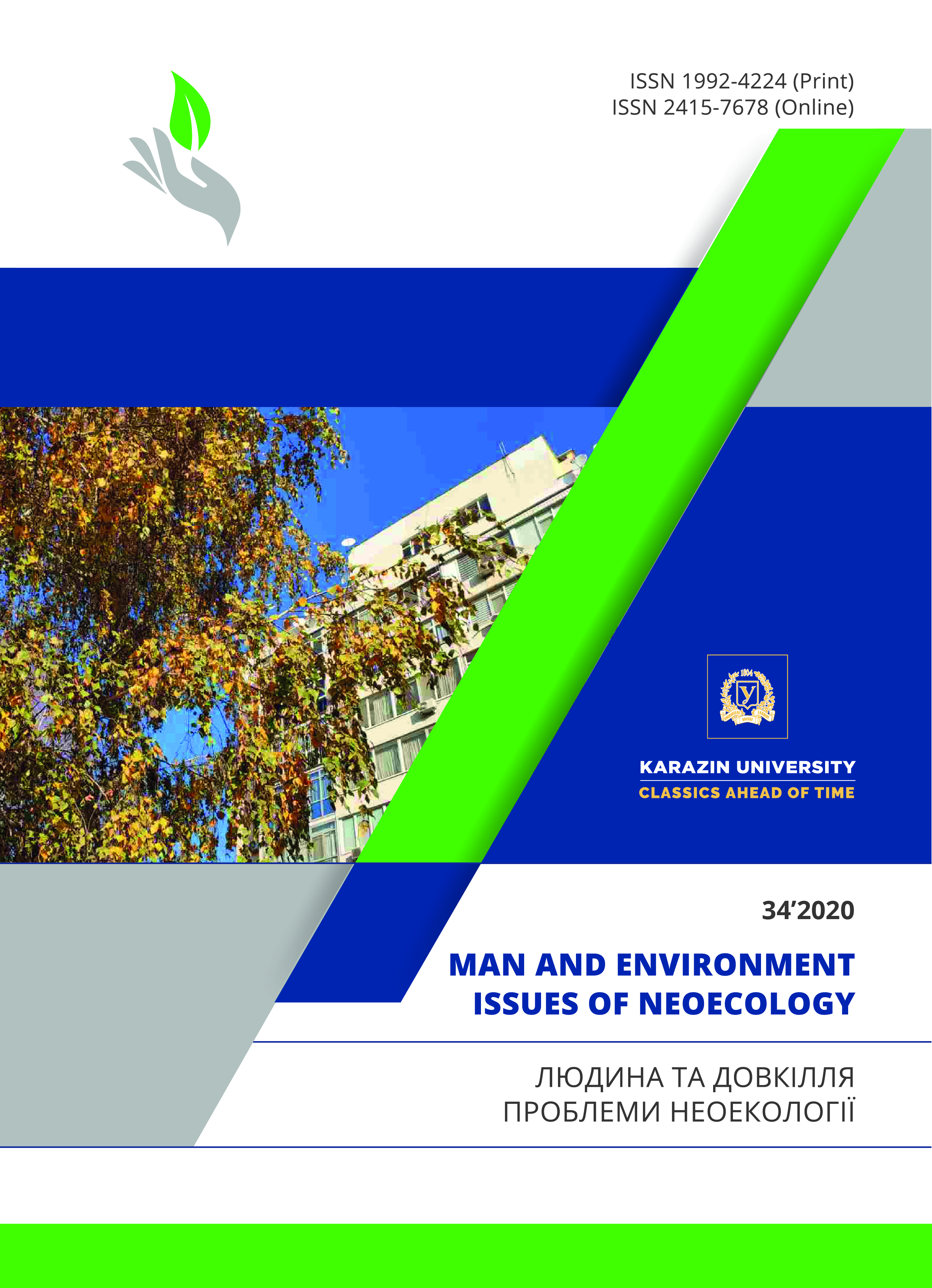До питання дослідження інформаційного забезпечення створення сталих агроландшафтів
Анотація
Мета. Охарактеризувати методичні підходи що розвиваються нами при формуванні системи інформаційного забезпечення створення та підтримання функціонування сучасних сталих агроландшафтів та показати результати їх впровадження на прикладі території деяких сільськогосподарських підприємств Харківщини.
Методи. Картографічні, геоінформаційного аналізу, розрахункові, статистично-математичні.
Результати. Розглянуто деякі результати роботи колективу з питань інформаційного забезпечення створення та підтримання функціонування сучасних сталих агроландшафтів: верифікації моделей ерозії, досліджень функціональності агролісомеліоративних насаджень, формування на масивах сільськогосподарських земель агроекомережі, що забезпечує підтримку сталого функціонування агроландшафтів мезо- та макрорівня, а також використання методів магніторозвідки для перевірки результатів математичного моделювання процесів ерозії.
Висновки. Розроблені методичні підходи забезпечують інформаційне формування системи до функціонування сталих агроландшафтів в природних та соціально-господарських умовах України. Вони стосуються функціонування протиерозійних заходів постійної дії, процесів сучасної трансформації агроландшафтів, екологічного впливу ерозійних процесів на довкілля. Показано зв'язок показника довжини лісосмуг на одиницю ріллі з еродованістю ґрунтів. Розроблено методичний підхід для оцінки кількості змитого з ріллі ґрунту та розрахунку заходів, необхідних для нівелювання його шкідливого впливу на довкілля.
Завантаження
Посилання
Baliuk, S. A., Medvediev, V. V., Vorotyntseva, L. I. & Shymel V. V. (2017). Productivity of grain of early hybrids of corn of different strain changings. Bulletin of Agrarian Science, 8, 5–11. Retrieved from https://doi.org/10.31073/agrovisnyk201708-01
Balyuk, S. A. & Tovazhnyansky, L. L. (Eds.). (2010). Scientific and applied bases of soil protection from erosion in Ukraine. Kharkiv: NTU "KPI". (In Ukranian).
Bulygin, S.Yu. (2005). Formation of ecologically sustainable agrolandscapes. Kyiv: Urozhay. (In Ukranian).
Morgan, R. P. S., Quinton, J. N., Smith, R. E. Govers, G., Poesen, J.W.A., Auerswald, K., Chisci, G., Torri, D., Styczen, M.E. & Folly, A.J.V. (1998). The European Soil Erosion Model (EUROSEM): documenta-tion and user quide. Version 3.6. Silsoe College Cranfild Universety, Silsoe, United Kingdom. Re-trieved from https://eprints.lancs.ac.uk/id/eprint/13189/1/user_v2.pdf
Flanagan, D. C., Gilley, J. E. & Franti, T. G. (2007). Water erosion prediction project (WEPP): development history, model capabilities, and future enhancements. Transactions of the American Society of Agricultural and Biological Engineers, 50(5), 1603-1612. Retrieved from https://www.ars.usda.gov/ARSUserFiles/50201000/WEPP/weppHistory.pdf
Larionov, G. A., Dobrovolskaya, N. G., Krasnov, S. F. & Liu B. Yu. (2003). New equation of the relief factor for statistical models of water erosion. Soil Science, 10, 1239 - 1247. Retrieved from https://www.elibrary.ru/item.asp?id=17288927 (In Russian).
Toth, G., Montanarella, L. & Russo, E. (2008). Treats to soil quality in Europe. Luxembourg: Office for official publications of the European communities. Retrieved from https://esdac.jrc.ec.europa.eu/ESDB_Archive/eusoils_docs/other/EUR23438.pdf
Bulygin S.Y., Nearing M.A. & Achasov A.B. (2002). Parameters of interrill erodibility in the WEPP model. Eurasian Soil Science, 35 (11) 1237 Retrieved from https://pubag.nal.usda.gov/download/7826/PDF
Alewell, C., Borrelli, P., Meusburger, K. & Panagos P. (2019). Using the USLE: Chances, challenges and limitations of soil erosion modeling. International Soil and Water Conservation Research, 7 (3). 203-225. Retrieved from https://doi.org/10.1016/j.iswcr.2019.05.004
Kutsenko, M.V. & Kruglov, O.V. (2010). About creation of the automated system of geoinformation support of the universal equation of expenses of soil (USLE). Geoinformatics, 4, 85-89. Retrieved from http://nbuv.gov.ua/UJRN/geoinf_2010_4_12 (In Ukranian).
World Bank. (2006). Sustainable Land Management: Challenges, Opportunities, and Trade-offs. Agriculture and Rural Development. Washington, DC: Wolrd Bank. Retrieved from http://hdl.handle.net/10986/7132
Belolipskyi, V. & Poluliakh, М. (2020). Application of the basin concept for soil and water protection arrangement of agro landscapes. Bulletin of Agrarian Science, 98 (6) 55-66. Retrieved from https://doi.org/10.31073/agrovisnyk202006-07 (In Ukranian).
Bondarev, V.P. (1996). Influence of neotectonics on the distribution of the ravine network of the Central Chernozem Region Vestnik of Moscow University. Geography, 5 (4), 41-45.
Kruglov, O.V., Timchenko, D.O., Nazarok, P.G. & Lizogubov V.O. (2015). System of geoinformation and technological support of measures for protection of soils from erosion taking into account regional features: scientific and methodical manual. Kharkiv. Aladdin-Print. (In Ukranian).
Shevchenko, M.V., Kolyada, V.P., Kruglov, O.V. & Demkin, O.O. (2016). Spatial distribution of soil erosion factors in the Kharkiv region. Bulletin of KhNAU. Crop production, selection and seed production, fruit and vegetable growing and storage, 2, 165–176. Retrieved from http://dspace.knau.kharkov.ua/jspui/handle/123456789/868(In Ukranian).
Kolyada, V.P., Shevchenko, M.V., Kruhlov, O.V., Achasova, A.O., Nazarok, P. G. & Hrebenchuk, O.O. (2018). Anti-erosion optimization of agricultural equipment: local level. Man and environment. Issues of neoecology, (1-2), 57-63. Retrieved from http://journals.uran.ua/ludina_dov/article/view/143819 (In Ukranian).
Communication from the commission to the European Parliament, the Council, the European economic and social committee and the Committee of the regions EU biodiversity strategy for 2030. Bringing na-ture back into our lives. com/2020/380 final Brussels, 20.5.2020 Retrieved from https://eur-lex.europa.eu/legal-content/EN/TXT/?qid=1590574123338&uri=CELEX:52020DC0380
Nazarok, P.G., Kruglov, O.V., Kutsenko, M.V., Menshov, O.I. & Sukhorada, A.V. (2015). To the problem of mapping erosion processes. Bulletin of Agricultural Science, 9, 63-68. Retrieved from https://agrovisnyk.com/pdf/en_2015_09_13.pdf (In Ukranian).
Автори, які публікуються у цьому журналі, погоджуються з наступними умовами:
- Автори залишають за собою право на авторство своєї роботи та передають журналу право першої публікації цієї роботи на умовах ліцензії Creative Commons Attribution License 4.0 International (CC BY 4.0), котра дозволяє іншим особам вільно розповсюджувати опубліковану роботу з обов'язковим посиланням на авторів оригінальної роботи та першу публікацію роботи у цьому журналі.
- Автори мають право укладати самостійні додаткові угоди щодо неексклюзивного розповсюдження роботи у тому вигляді, в якому вона була опублікована цим журналом (наприклад, розміщувати роботу в електронному сховищі установи або публікувати у складі монографії), за умови збереження посилання на першу публікацію роботи у цьому журналі.
- Політика журналу дозволяє і заохочує розміщення авторами в мережі Інтернет (наприклад, у сховищах установ або на особистих веб-сайтах) рукопису роботи, як до подання цього рукопису до редакції, так і під час його редакційного опрацювання, оскільки це сприяє виникненню продуктивної наукової дискусії та позитивно позначається на оперативності та динаміці цитування опублікованої роботи (див. The Effect of Open Access).





